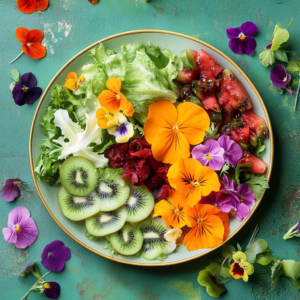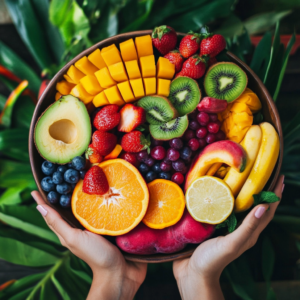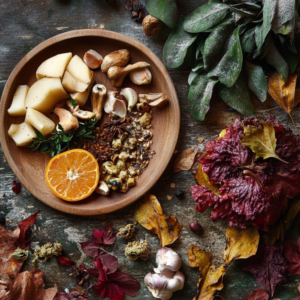Introduction
Welcome, fellow food enthusiasts! I’m excited to share with you my comprehensive guide on Seasonal Vegan Recipes: Fresh Ideas for Every Season. Over the years, I have discovered that cooking with seasonal produce not only enhances the flavor of meals but also maximizes nutritional value and supports sustainable eating practices. In my journey toward a healthier, plant-based lifestyle, I learned that embracing seasonal vegan recipes is a key component to maintaining variety and excitement in the kitchen. This article will provide you with creative recipes, practical tips, and expert insights on how to incorporate fresh, seasonal ingredients into your vegan cooking. Whether you’re a seasoned vegan cook or just starting out, I hope this guide inspires you to celebrate the bounty of each season and transform your meals into a delightful culinary adventure. For additional insights on plant-based nutrition, I recommend reading 10 Essential Vegan Nutrition Tips for a Healthier Life.
Understanding Seasonal Vegan Recipes
Learning to cook with seasonal ingredients means that you are in tune with nature’s cycles. When you embrace seasonal vegan recipes, you benefit from produce at its peak flavor and nutritional density. In my experience, this approach not only elevates the taste of my dishes but also reduces environmental impact and supports local agriculture. Let’s explore how different seasons can inspire unique, delicious vegan recipes.

1. Why Seasonal Vegan Recipes Matter
Seasonal vegan recipes are more than just a trend—they are a way to connect with nature and make your meals as nutritious as possible. When you choose produce that is in season, you not only enjoy better flavor and texture but also access foods that are naturally abundant and often more affordable. In my experience, seasonal eating leads to a more varied diet, which in turn helps to balance nutrient intake. Additionally, seasonal recipes encourage creativity, allowing you to experiment with a wide range of ingredients and cooking techniques throughout the year.
a. Embracing Freshness and Flavor
Fresh produce harvested in season is at its peak of flavor and nutritional value. This means that your recipes will be bursting with taste and vitamins. I’ve found that dishes made with seasonal fruits and vegetables have a natural vibrancy that processed foods can’t match. Seasonal vegan recipes not only taste better—they help preserve the integrity of the ingredients, ensuring that every bite is both delicious and nourishing.
b. Enhancing Nutrition Through Seasonal Produce
Eating seasonal produce ensures that you get the best possible nutrients. Fruits and vegetables have higher nutrient levels when they are in season, which means that your meals become more effective in supporting your overall health. Incorporating seasonal ingredients into your vegan recipes can help boost your immune system, improve digestion, and increase energy levels. In my personal experience, I feel more energized and connected to my food when I prepare meals that align with the seasons.
2. Spring Vegan Recipes: Celebrating New Beginnings
Spring is a time of renewal and vibrant growth. It brings with it an abundance of fresh greens, tender vegetables, and delicate fruits that are perfect for light, refreshing meals.
a. Light and Refreshing Salads
In spring, I love to create salads that feature crisp baby greens, radishes, asparagus, and edible flowers. One of my favorite recipes is a spring quinoa salad that combines these ingredients with a zesty lemon-tahini dressing. The salad is not only refreshing but also packed with protein and fiber, making it a perfect meal for a warm spring day. Incorporating fresh herbs like mint and basil adds an extra burst of flavor that truly captures the essence of the season.
b. Creative Plant-Based Appetizers
Spring also offers a great opportunity to experiment with innovative appetizers. For instance, I often prepare fresh spring rolls using rice paper filled with an assortment of crisp vegetables, avocado, and fresh herbs. A side of peanut dipping sauce complements these rolls perfectly. These dishes are light, satisfying, and beautifully showcase the fresh produce available during this season. They’re a testament to how seasonal vegan recipes can transform simple ingredients into gourmet treats.
3. Summer Vegan Recipes: Energizing and Cooling Meals
Summer is synonymous with warmth, abundance, and a variety of colorful produce. It’s the perfect season to enjoy meals that are both energizing and cooling.
a. Vibrant Smoothies and Bowls
During the hot summer months, I rely on smoothies and smoothie bowls to keep my energy levels high and my body hydrated. Blending together frozen fruits such as mangoes, berries, and bananas with a handful of spinach or kale, and a splash of coconut water or almond milk, creates a thick, refreshing beverage that is both nutritious and satisfying. Topping these bowls with granola, fresh fruit slices, and a sprinkle of chia seeds adds a delightful crunch and extra nutritional benefits.
b. Grilled Vegetables and Refreshing Salsas
Summer is also the ideal time for grilling. I enjoy marinating vegetables like zucchini, eggplant, bell peppers, and corn in olive oil, garlic, and fresh herbs before grilling them to perfection. These grilled vegetables can be served on their own or incorporated into vibrant salsas. A fresh mango salsa, for example, made with diced mango, red onion, cilantro, and a squeeze of lime, adds a burst of tropical flavor that pairs beautifully with grilled veggies. These dishes are a prime example of how seasonal vegan recipes during summer can be both refreshing and hearty.

4. Autumn Vegan Recipes: Warm and Comforting Dishes
As the weather cools down in autumn, the harvest brings a rich variety of root vegetables, squashes, and hearty greens. This season is perfect for creating comforting, warm meals.
a. Hearty Soups and Stews
Autumn is the ideal season for soups and stews that warm the soul. I love preparing a robust lentil soup loaded with carrots, potatoes, and kale, seasoned with herbs like thyme and bay leaves. The natural sweetness of roasted butternut squash also lends itself beautifully to creamy soups blended with coconut milk. These recipes are not only comforting but also provide a balanced mix of protein, fiber, and vitamins essential for the cooler months.
b. Root Vegetable Roasts and Grain Bowls
Roasting is a popular cooking method in autumn, as it brings out the natural sweetness of root vegetables. I often roast a medley of carrots, parsnips, and sweet potatoes with olive oil, salt, and rosemary, then toss them with cooked quinoa or farro for a nourishing grain bowl. A drizzle of tahini dressing ties the flavors together, creating a hearty, satisfying meal that perfectly encapsulates the spirit of autumn. Such dishes highlight how seasonal vegan recipes can be both rustic and elegant, offering comfort during the transition into cooler weather.
5. Winter Vegan Recipes: Nourishing and Cozy Meals
Winter calls for recipes that are rich, hearty, and deeply comforting. When the temperatures drop, I rely on dishes that are both warming and nutritious.
a. Rich Casseroles and Curries
During winter, I prepare dishes that are designed to warm you from the inside out. A classic winter vegan casserole, for example, might include layers of roasted vegetables, lentils, and a creamy cashew sauce baked to perfection. Similarly, hearty curries made with chickpeas, spinach, and coconut milk provide a warming, satisfying meal that is perfect for cold days. These recipes demonstrate how winter vegan recipes can be both indulgent and healthful, delivering comfort food that nourishes the body and soul.
b. Festive Desserts and Beverages
Winter is also a time for festive treats. I enjoy making seasonal desserts such as vegan gingerbread cookies and spiced apple crumbles. These desserts use warming spices like cinnamon, nutmeg, and cloves to evoke the cozy feeling of the season. For beverages, I often prepare a hot, creamy almond milk latte with a hint of cocoa and cinnamon, which serves as the perfect end to a chilly day. Winter vegan recipes not only provide comfort but also celebrate the unique flavors of the season.
6. Tips for Adapting Recipes to the Seasons
One of the joys of cooking vegan is the ability to adapt recipes according to seasonal availability. Here are some tips that I’ve found invaluable in aligning my meals with the rhythms of nature:
a. Utilizing Local and Organic Produce
When possible, I always choose locally sourced and organic produce. Not only does this support local farmers and reduce my carbon footprint, but seasonal fruits and vegetables tend to be fresher and more nutrient-dense. This approach ensures that my seasonal vegan recipes are as flavorful and healthy as possible.
b. Meal Planning for Each Season
I plan my meals according to the season, which helps me take advantage of the best ingredients available. For example, in spring and summer, I incorporate more raw and lightly cooked dishes, while in autumn and winter, I focus on hearty, slow-cooked recipes. This seasonal meal planning not only adds variety to my diet but also helps me manage my grocery shopping and reduce food waste. It’s a practical strategy that aligns with the philosophy behind seasonal vegan recipes.

7. Internal and External Resources for Further Inspiration
To continue your journey with seasonal vegan recipes, I highly recommend exploring a variety of resources that offer further inspiration and practical tips.
a. Internal Resources
• For more creative vegan recipes and nutritional insights, check out Quick and Delicious Vegan Recipes for Busy Weeknights.
• To expand your understanding of plant-based nutrition, explore 10 Essential Vegan Nutrition Tips for a Healthier Life.
• For budget-friendly meal ideas that make seasonal eating easy, visit Budget-Friendly Vegan Meals That Don’t Sacrifice Taste.
b. External Resources
For additional dietary guidelines, I recommend visiting Nutrition.gov, and for peer-reviewed research, refer to PubMed. Additionally, a highly regarded YouTube video from a trusted channel offers practical advice and creative inspiration on seasonal eating and vegan nutrition.
8. Frequently Asked Questions (FAQ) About Seasonal Vegan Recipes
Common Queries Answered
Q1: Why should I focus on seasonal vegan recipes?
A1: Seasonal vegan recipes allow you to take advantage of produce at its peak flavor and nutritional value. They also support sustainability by promoting the use of local, in-season ingredients and can be more economical.
Q2: How do seasonal ingredients enhance vegan recipes?
A2: Ingredients harvested in season tend to be fresher, tastier, and more nutrient-dense. This results in recipes that are not only healthier but also more flavorful and visually appealing.
Q3: Can seasonal vegan recipes be adapted to different regions?
A3: Absolutely. While the specific ingredients may vary by region, the principles of seasonal cooking remain the same. You can substitute local produce for those mentioned in recipes, ensuring that your meals are always fresh and relevant to your area.
Q4: What are some essential seasonal vegan recipes to try?
A4: In spring, try fresh salads and light appetizers; in summer, enjoy smoothies, grilled vegetables, and salsas; in autumn, prepare hearty soups, stews, and grain bowls; and in winter, indulge in rich curries, casseroles, and festive desserts. These options provide a well-rounded approach to seasonal vegan cooking.
Q5: How can I plan my meals around seasonal produce?
A5: Meal planning is key. Review seasonal produce guides, plan your weekly menu based on what’s fresh, and shop at local markets. This strategy ensures you’re making the most of available ingredients and keeps your vegan diet varied and exciting.
Q6: Are seasonal vegan recipes cost-effective?
A6: Yes, seasonal produce is often more affordable and abundant than out-of-season items. By focusing on local and in-season ingredients, you can reduce costs while enjoying high-quality, nutritious meals—a strategy that supports sustainable eating habits.
9. Conclusion and Final Thoughts on Seasonal Vegan Recipes
In conclusion, incorporating seasonal vegan recipes into your diet is a powerful way to enhance flavor, boost nutrition, and embrace a sustainable lifestyle. Cooking with seasonal ingredients not only ensures that you enjoy produce at its peak but also aligns your eating habits with nature’s rhythms. My journey into seasonal vegan cooking has enriched my culinary experiences, expanded my recipe repertoire, and deepened my commitment to both my health and the environment. I hope this comprehensive guide on Seasonal Vegan Recipes: Fresh Ideas for Every Season has provided you with inspiration, practical tips, and creative ideas to transform your kitchen into a space of innovation and nourishment. Embrace the freshness of each season, experiment with new recipes, and let the vibrant flavors of nature elevate your plant-based lifestyle.For those interested in learning more about this topic, we recommend this vegan cookbook.